The chameleon may be the world’s most recognizable color-changing animal, but that doesn’t mean that it’s the only creature of its type on the planet.
There are more than 20 birds and mammals that can change color to adapt to their environments, and that’s not even taking into consideration the myriad insects, amphibians, fish, and reptiles with their own color-changing capabilities. Here is a preview of the 10 animals that change color that we are featuring:
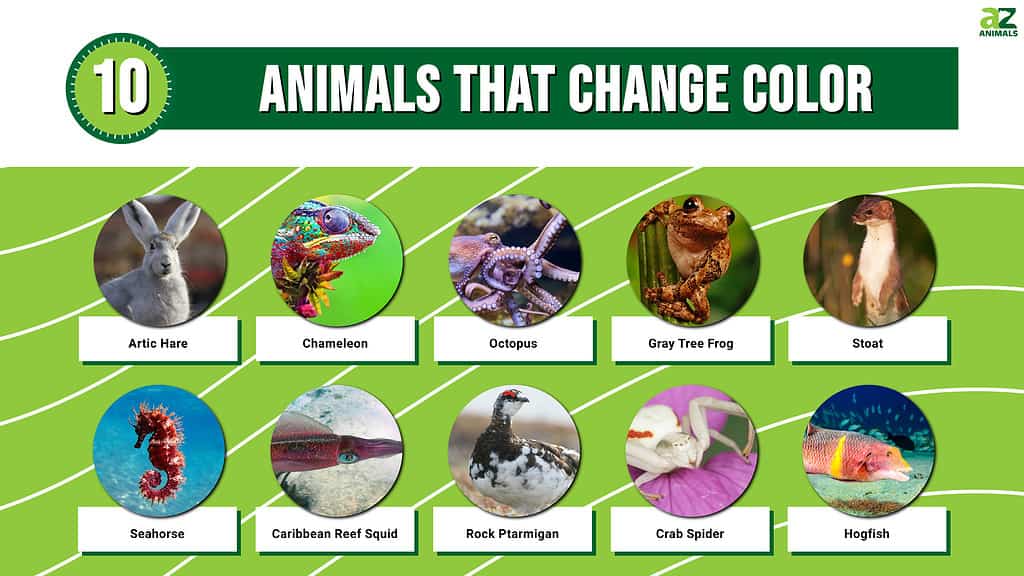
While the color change process is most often used as a defense mechanism, it can be used for regulating temperature, attracting mates, and even communicating socially.
Here are 10 of the world’s most unique color-changing animals and the creative ways they employ this skill for survival.
#10 Animals That Change Color: Arctic Hare — Changing Its Look to Match the Season

©Sophia Granchinho/Shutterstock.com
Winters tend to be long in the parts of North America that the Arctic hare inhabits, but the snowfall brings with it a new form of cover for these prey creatures.
While the arctic hare’s coat is brown and gray during the warmer seasons, they shed this coat in favor of white fur as things grow colder.
While scientists aren’t quite sure how this change occurs, they believe that it’s related to the amount of light received during the day.
As the days grow shorter, the hare’s body triggers the transformation. In fact, arctic hares in the farthest northern reaches tend to be white all year long.
Unfortunately, there are concerns that climate change may be disrupting the color change cycle of these rabbits and could make them sitting targets for predators like foxes and wolves.
You can learn more about the arctic hare — like the fact that it can hop like a kangaroo — here.
#9 Animals That Change Color: Chameleon — An Incredibly Sophisticated Approach to Camouflage

©Graphics Illuminate/Shutterstock.com
While it’s commonly believed that chameleons change their skin tone to match their environment, this power serves a more practical and immediate purpose: to regulate body temperature.
Since chameleons are incapable of generating body heat, they instead regulate the level of heat they absorb from the sun by changing their coloring. But this talent is also used as a way of communicating with one another.
Chameleons eyesight has developed to help them escape predators, blend in, or catch prey. They can focus their eyes very well and are adapt to judging distances and spot prey between 5 and 10 metrics. Chameleon are also able to see in ultraviolent light which isn’t visible to the naked eye of humans.
Coloring can be used to indicate aggression between two territorial males, or it can be a way of demonstrating that a chameleon is amenable to breeding.
All of this is regulated through an internal sack that changes the body color through the use of just four different pigments — brown, blue, red, and yellow.
There are more than 160 different chameleon species, and you can learn all about them here.
#8 Animals That Change Color: Octopus — Conscious and Immaculate Color Changing Capabilities
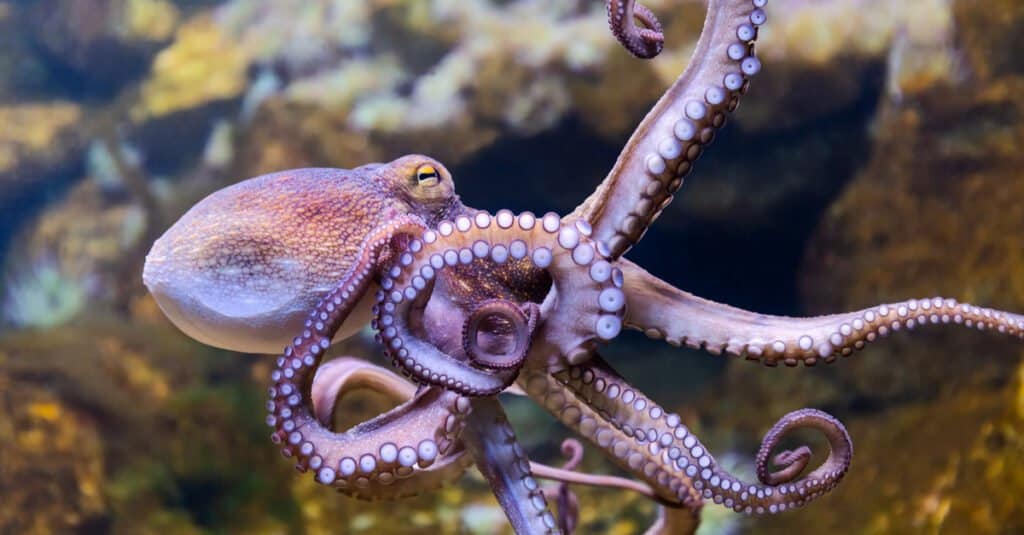
©Henner Damke/Shutterstock.com
The specialized cells that provide chameleons with their color-changing pigments are called chromatophores — and while octopuses also used chromatophores to change the coloring of their body, they are unique in that each of these cells is connected to a nerve ending.
There’s a conscious effort by the nervous system to adapt colors, and that extra level of efficiency is likely because the octopus has little in the way of other defense mechanisms.
Depending on the predator or the breed of octopus, they may use their chromatophores to blend into the environment or by flashing bright colors as a way to signal to predators that they’re venomous.
Many octopuses can even change the texture of their skin to better blend in.
The octopus is highly intelligent despite possessing dramatically different neurology from humans, and you can dig more into this fascinating creature here.
#7 Animals That Change Color: Gray Tree Frog — A Combination of Camouflage and Caution
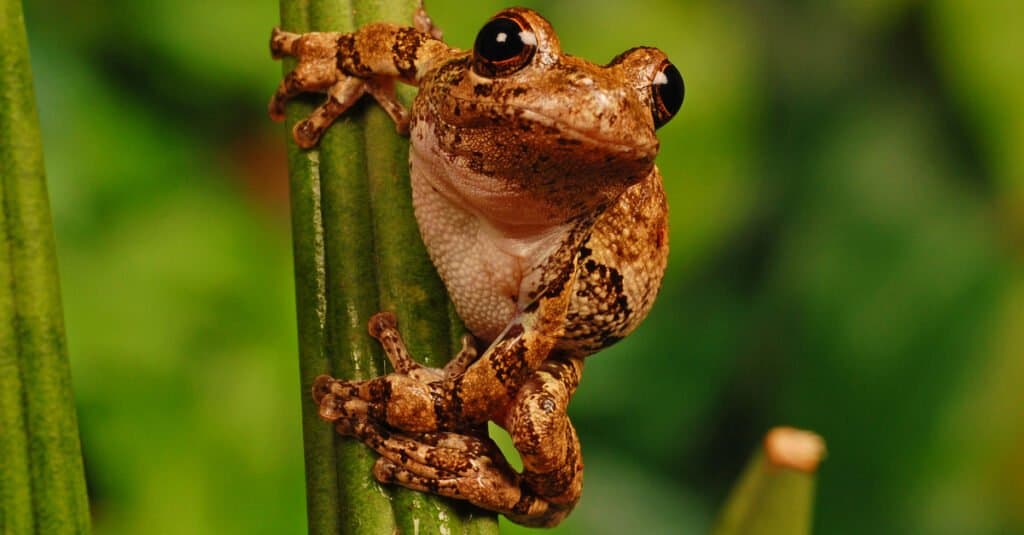
©Deatonphotos/Shutterstock.com
The vast and complex systems of camouflage that have been developed by the chameleon and octopus aren’t going to be a necessity for every creature — and that’s a point underscored by the gray tree frog.
The natural patterns of the gray tree frog are designed to mimic the look of the lichen that dominates the environments they live in, and they’re capable only of changing between shades of gray, green, or brown.
Interestingly, the underside of the frog tends to be a bright and vibrant orange — perhaps as a warning to predators that the frog may be poisonous.
The gray tree frog is just one variation of tree frog, and you can learn about the various species here.
#6 Animals That Change Color: Stoat — Camouflage That’s Both Asset and Liability
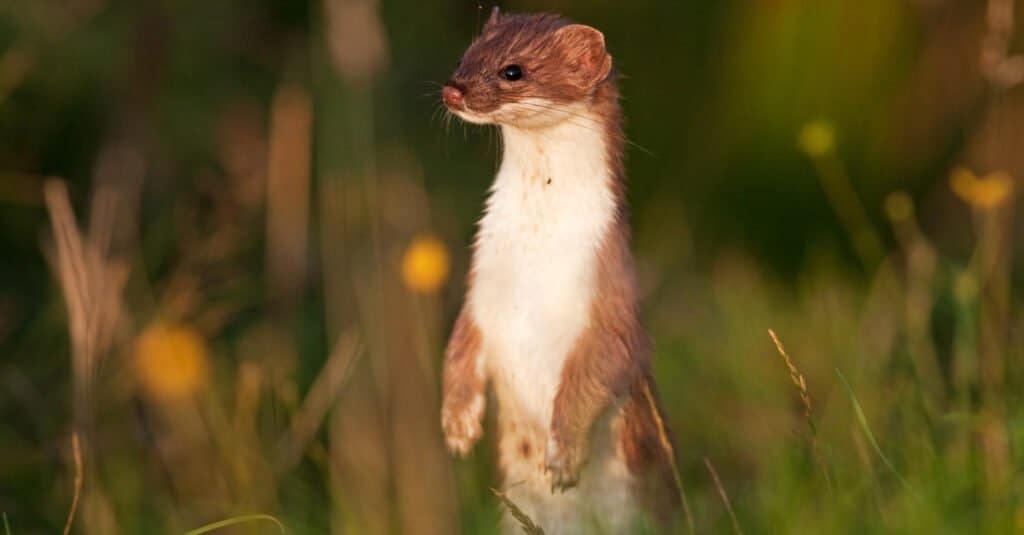
©Martin Prochazkacz/Shutterstock.com
The ability to change color often develops as a way to elude predators, but the stoat’s camouflage actually makes it more vulnerable to one of the most deadly predators of all — humans.
The stoat shifts between brown and white fur according to the season in much the same way as the arctic hare, but the fact that their winter coat is both snow white and incredibly luxurious has made these animals prey for furriers and trappers in the past.
It’s a phenomenon that previously left stoats on the brink of extinction.
Stoats are now considered a species of least concern thanks to their stabilized population over the past few decades, but you can learn plenty more about them here.
Stoats belong to the mustelid family, they are known as the short tailed weasel. The stoat is actually nominated as one of the world’s 100 most invasive species. They are small animals and males only reach about 32 cm long, whereas females are about 27 cm in length.
#5 Animals That Change Color: Seahorse — Wearing Their Hearts on Their Skin

©Vojce/Shutterstock.com
There are 43 recognizes species of seahorse, but they all have in common the ability to change their color on a whim.
And while this serves as a defensive mechanism, but it can also reasonably be considered a way of expressing personal identity.
Coloring can actively be changed to blend into the environment — but the coloring of a seahorse can also be varied according to their age, diet, or even their mood.
A brilliant color change may just look like a simple thing of beauty while snorkeling — but other seahorses might recognize it as an offer to mate or a territorial threat.
Male seahorses actually give birth to their young, but that’s just one of many facts you can learn about this fascinating fish here.
#4 Animals That Change Color: Caribbean Reef Squid — Communication Through Light Show
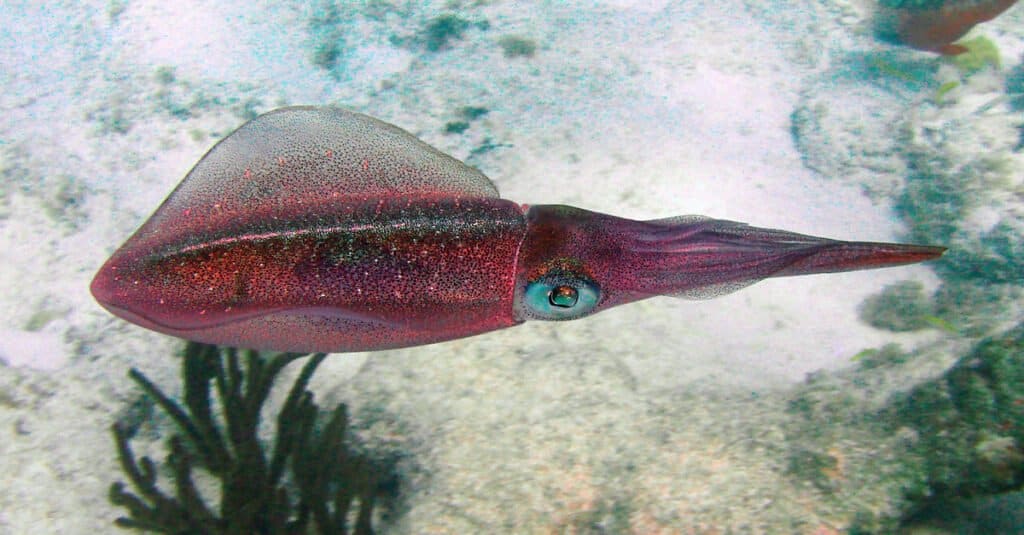
©Ernie Hounshell/Shutterstock.com
The mottled green or brown coloring of the Caribbean reef squid wouldn’t stand out as extraordinary in most diving expeditions, but their varied capacity for changing their pigmentation is actually the key to a complex system of communication.
In addition to camouflaging itself against underwater surfaces, it can assume several iridescent shades.
Depending on the coloring and location of these spots, the sociable reef squid can use pigment to send warnings to fellow squid, announce its readiness to mate, and even identify itself to others.
This, combined with several body language cues, reveal a level of social structure that’s quite complex.
Most people know that squid use ink to hide from predators, but you can learn more obscure facts about this sea creature here.
#3 Animals That Change Color: Rock Ptarmigan — Changing Color With the Season

©Tatiana Ivkovich/Shutterstock.com
The Rock ptarmigan earned its name for its ability to blend in with the rock — or the snow or the dirt, depending on the time of the season — in the Arctic environments they call home.
They molt seasonally in much the same way as arctic rabbits, shifting from white to gray to brown as the seasons demand. That need for camouflage likely wouldn’t be the case if these birds spent less time on the ground.
The ptarmigan is capable of flight, but regular flight requires a great deal of energy in an environment where food tends to be scarce.
The ptarmigan is just one member of the grouse family, which you can learn about here.
#2 Animals That Change Color: Crab Spider — Nature’s Tattoo Artist

©HWall/Shutterstock.com
The crab spider earned its name for the way it walks, but a specific member of the family earned a place on this list thanks to the fact that it can change between shades of yellow and white.
But unlike any of the other animals on this list, they do so by actually changing the pigments that their body produces. That means that the process is much slower than other animals — anywhere from a couple of days to a few weeks.
Researchers haven’t agreed on exactly why the crab spider changes color, but it definitely helps them blend in with the yellow and white corn daisy flowers where they tend to perch in wait for prey.
Some crab spiders blend in by resembling bird or ant droppings, and you can learn more here.
#1 Animals That Change Color: Hogfish — Sensing Color With Its Skin
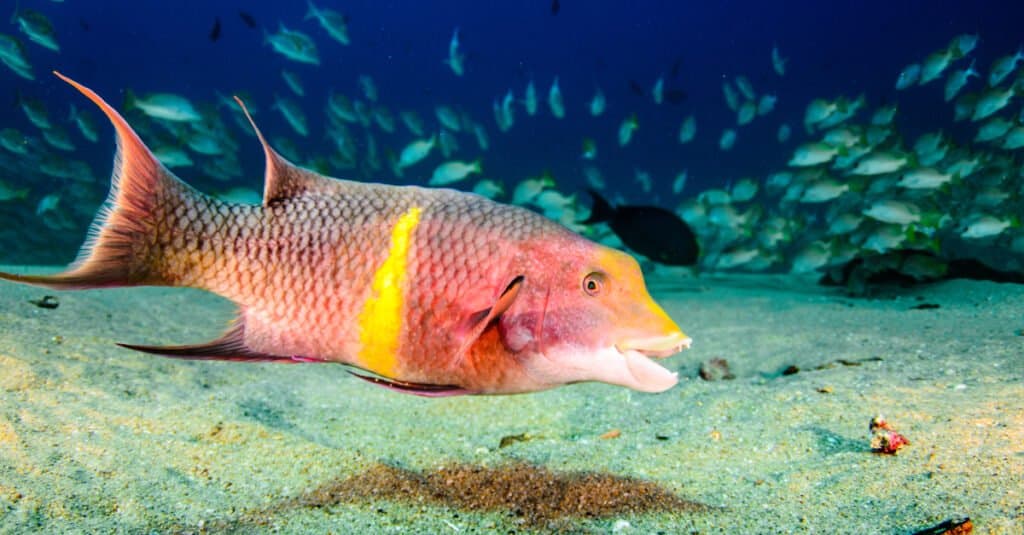
©Leonardo Gonzalez/Shutterstock.com
Like many of the animals on this list, the hogfish uses special cells called chromatophores to shift its coloration — but the science on this strange-looking fish indicates that the hogfish might actually be able to sense color through touch.
While DNA analysis of other color-changing animals like octopuses and cuttlefish indicate that their skin essentially works like human eyes do at filtering light, an RNA readout of a hogfish subject seems to demonstrate that this fish’s abilities to see with its eyes and sense color with its skin were activated using different genes.
The mystery behind how the hogfish’s unique sense operates remains a mystery, but it’s known that hogfish use their color-changing properties to attract mates and threaten competitors in addition to serving as a traditional form of camouflage.
Summary
Animals are amazing, and they can be even more amazing if they change color to match their environment. Here is a review of the 10 animals we have discussed that change color:
| Name of Animal | Highlight | Purpose of Change |
|---|---|---|
| Hogfish | Sensing Color with its Skin | Camoflauge, attract mate, threaten competition |
| Crab Spider | Nature’s Tatoo Artist | Unknown purpose, but blends with flowers where it waits for prey |
| Rock Ptarmigan | Changing Color with the Season | Gray or brown if among rocks or dirt, white if snow |
| Caribbean Reef Squid | Communication through Light Show | Send warnings, attract mate, express identity |
| Seahorse | Wearing Their Hearts on Their Skin | Deter predators, express identity or mood, attract mate |
| Stoat | Camouflage That’s Both Asset and Liability | Seasonal – turns from brown to white in snow |
| Gray Tree Frog | A Combination of Camouflage and Caution | Patterns mimic the lichen of its habitat |
| Octopus | Conscious and Immaculate Color Changing Capabilities | Camouflage, deter predators |
| Chameleon | An Incredibly Sophisticated Approach to Camouflage | Regulate body temperature, communication, territorial aggression, breeding signal |
| Arctic Hare | Changing Its Look to Match the Season | Gray or brown in warmer seasons, white when cold. |
Next Up…
- Silverback Gorillas vs Grizzly Bears: Who Would Win in a Fight? – Who do you think would win in a fight between a Silverback Gorilla or a Grizzly Bear? Find out here.
- 5 of the Biggest Spiders in Montana – Montana is known for it’s beauty and it’s wilderness. Here are 5 of the biggest spiders you can find there.
- 21 Snakes In Washington – Washington is a stunning state, however, in the lush environment 21 snakes call Washington home.
The photo featured at the top of this post is © Vojce/Shutterstock.com
Thank you for reading! Have some feedback for us? Contact the AZ Animals editorial team.






